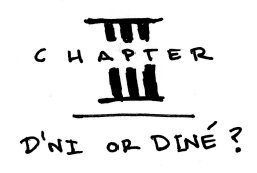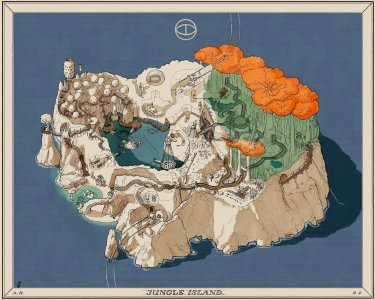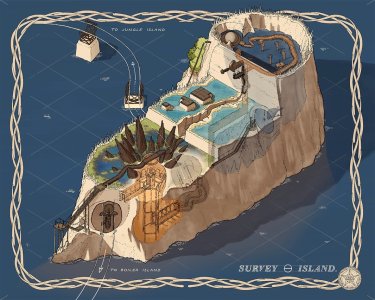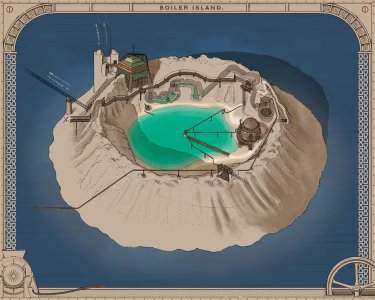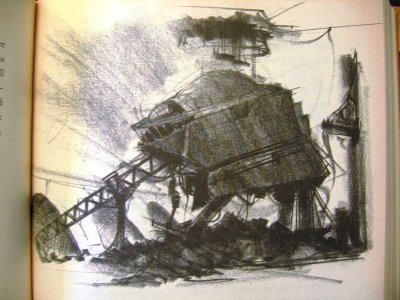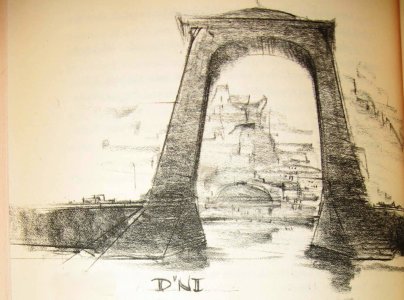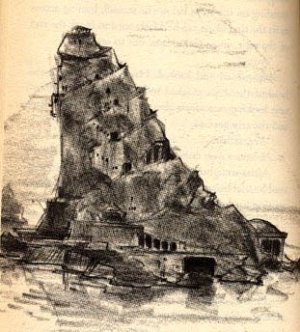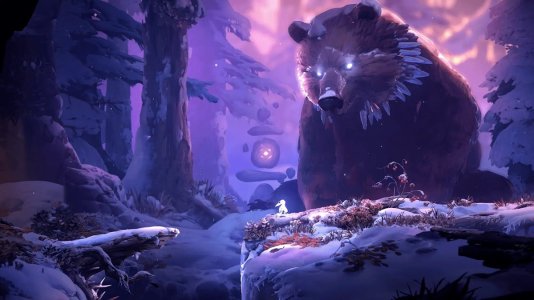_____Already I've got to backtrack a bit because I've realized that it would not be possible to explore the thematic content of the novels without spoiling key elements of their plots which are meant to be revealed in the course of the narrative. And all three of those
Myst novels are terrific and transcend the video game series to be well worth reading for their own sake so I don't want to spoil them. Let me instead stick to how this topic relates to
Riven. The plot of
Riven is pretty simple compared to a lot of other adventure games, which is by design. The gameplay ethos at work here is one of player exploration rather than linear storytelling. There are a number of different possible endings depending on the choices that the player makes but several elements of the story are consistent throughout. We know that Aitrus, the character we spoke to in the first
Myst game, needs our help once again in dealing with his family but this time it's his father (Gehn) who he wants us to trap in a prison book. First we've got to free his wife Catherine who has been imprisoned by Gehn somewhere in
Riven (behind bars in her case, not in an Age with no linking book to get out of it). The bulk of this game then is made up of trying to navigate the puzzles impeding our progress in order to locate Catherine.
_____En-route to reaching Catherine we are free to explore the world of
Riven and there are several opportunities to interact with native Rivanese people and learn aspects of their culture. Most of the Rivanese we encounter in person early on (through embedded video clips of actors filmed in front of a blue screen then composited into the virtual environments) simply run away from us. The bulk of the cultural exchange, then, happens
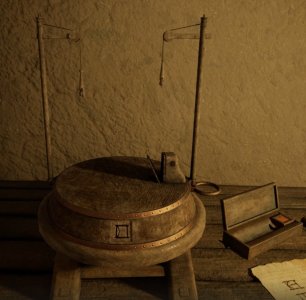
by interacting with artifacts rather than with people. For instance, in the empty cliff village there is a school house with a children's toy meant to teach us how to count in D'Ni numerical notation. This notation is utilized in a few of the games puzzles so learning it is not optional in the same way that reading the journal entries scattered about to understand the backstory is. This also serves a convenient game design purpose: were we able to simply ask someone what the symbols mean we could arrive at the solution quicker. Instead we are forced to discover their significance through experimentation.
_____I already explained briefly in Chapter I the premise of the expanded
Myst fictional universe but I'll paraphrase it again here. A group of people called the D'Ni -- pronounced as
duh (think Bart Simpson)
+ ni (same as the word knee)
-- have the ability to write descriptive books which outline environments (called Ages) that
could exist or do exist in a parallel universe and then through a mysterious and unexplained process involving how the paper and ink are prepared, the books themselves become portals which the D'Ni use to link into those Ages and interact with the inhabitants. In Chapter I my purpose was only to comment on this meta-narrative in the context of a broader movement in video games from word-based storytelling to picture-based storytelling. From this basic premise though, we can also see the suggestion of a dramatic theme emerging. If these authored Ages are not empty but can have inhabitants, what responsibility do the D'Ni have, as authors, toward those inhabitants? Should authorship grant them hegemonic status? Does knowing that an Age they've written is not empty of life change how a D'Ni author should think about further revisions to that work?
_____In this way
Myst uses the concept of authorship to explore themes of colonialism and xenophobia from a unique perspective. When the D'Ni enter an Age (Riven being one such Age -- Gehn's 5th authored age, as we are frequently told throughout the game) they too are explorers. In order to communicate with the people living in that Age, a cultural exchange must first take place. This puts the D'Ni in the same position as a European colonist arriving on a new continent for the first time. Neither side knows the other's cultural beliefs and motivations. While working to establish a means of communication we can imagine them also working to establish whether these unknown people are friend or foe. And in our encounters with the Rivanese and their environment we can clearly see them making that same determination about us.
_____I think it is worth stopping to emphasize here that
Riven is a game where 'anthropology' is the core means with which the player is interacting with the game environment. All of those objects -- the glowing fire marble lanterns, the ceremonial daggers, the many rotating domes and transportation systems, the children's counting toy -- are not merely decorative nor are they functioning (as many of the puzzles in
Myst were) only as gameplay mechanisms to solve. They are an
essential part of the game's storytelling as well. Returning to the counting toy, we can
see immediately that this simple mechanical device is clearly intended to teach Rivanese children more than just numbers. The toy takes the form of a hand-carved diorama showing misbehaving Rivenese villagers being fed to a giant walrus-like creature called a wahrk. Were this depiction unclear, the actual platform used to perform this ritual for real is located in the lake nearby. In this way we are not just learning about the Rivenese through our exploration, we are also learning about Gehn, the game's antagonist and the D'Ni author of this Age.
And what we learn puts him quite firmly in the category of 'foe'.
_____As a quick diversion, the financial success of
Myst gave birth to a parody game called
Pyst which was essentially (from what I could tell from screenshots) the same idea but with trash strewn all over the uninhabited fantasy world the player was exploring. The premise of
Pyst is that so many people had gone to this little island and left their trash behind that it's now become a dump. Having taken the time to author three novels of backstory in the years between
Riven and
Myst, the Miller brothers and their expanded team of designers at Cyan Worlds arrived at a similar premise for
Riven. Rather than wandering through a pristine environment as we were in
Myst, we ar

e now wandering through an environment on the verge of collapse with the scars of industrialization and land exploitation plainly apparent around us. Two of the islands prominently feature a clear-cut forest and a polluted lake. When we eventually find Catherine her prison island is built out of the remains of an enormous tree which has been cut down. Of the remaining two islands, one hosts the throne room referenced in Chapter II and the other features a temple dedicated to the worship of Gehn as a deity.
_____So if you want to tell a story about a megalomaniacal man who comes from an ancient people who were prone to arrogance and his despotic rule over an island culture he believed himself to be separate from and above and you intend to tell that story almost entirely through pictures, one way to accomplish that would be to lean into a symbolic visual short-hand which borrows heavily from historical tropes. The native people we encounter in
Riven build earthen homes and craft their tools out of easily obtainable wood and bone. They construct totems and effigies and create art which references aspects of the natural environment around them. Gehn, by contrast, builds his structures out of granite, metal, and stone masonry and animates them with mechanical contraptions that
consume aspects of the natural environment. The contrasting value systems of the Rivanese and Gehn as depicted in these structures and artifacts are so closely aligned with indigenous cultures and colonizing European cultures, respectively, that casting Gehn as the antagonist of the story reads like a clear indictment of the practice of colonization. It's not quite as "hit you over the head with overt symbolism" as James Cameron's
Avatar films but it's not far off either.
_____A lot of different existing cultures were referenced in creating the Rivanese culture. The language they speak is adapted from a language spoken in Papua New Guinea. Their village dwellings are constructed high up on the cliffs similar to the Pueblo culture of the American Southwest. The underground rebel faction we eventually meet use bola (a thrown weapon invented by people indigenous to the North and South American continents) and have constructed an elaborate series of wooden structures throughout the game world which they've coded with pictographic representations of animals found in
Riven. But there is one other point of reference which I haven't found much discussion on and that is the similarity between the fic
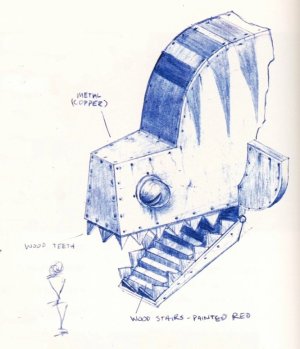
tional culture of the D'Ni, invented to fill out Myst's backstory and the real-life Navajo cosmology. Diné -- pronounced as
din (first syllable of dinner) +
A (the letter 'A' or the Canadian eh?) is a Navajo word which means 'people'. Basically it refers to the collective
we, all of us. In the Navajo creation story, our present world is the fourth iteration of the world and in order to get here we emerged from a previous world in which we lived underground, disharmoniously. Later in the series, the Miller brothers would further iterate upon these ideas culminating in an online multi-player game called
Uru where players enter the underground D'Ni city through a series of tunnels that emerge in modern-day Arizona.
_____The design team at Cyan Worlds also directly referenced Navajo culture in another, more tangible way. In order to bring their 3D modeled geography to life, they took a series of close-up photographs of various types of materials in Santa Fe, New Mexico and then applied these photographs as surface textures to effectively paint between the lines on those 3D models. Why New Mexico? According to Robyn Miller the decision was made to source all of these texture photos of wood, brick, metal, stone, etc. in a desert environment that closely resembled the one they were building. So if wandering around
Riven reminds you just a bit of textures that you've seen in Arizona and New Mexico, there's a good reason -- that is exactly what you're seeing pasted all around you. This is how it was possible to make a game in the mid 1990s that looked photo-real. And even today if you go load up a copy of the original
Riven release, the effect is still pretty convincing. We have 8K digital cameras now and processors which can handle amounts of data that were almost impossible to imagine 30 years ago so it would be unreasonable to expect those images to compare favorably with the state of the art now, but they come closer than anything else from their era.
_____Here's where I would like to ask you (hypothetical reader) a question; a rhetorical one since this is in essay form. Because the Miller brothers chose to tell a story about colonization, exploitation, and the use of theology to manipulate and control people and focused the gameplay mechanics of
Riven around the act of anthropological study, does that justify their borrowing of elements from other cultures to suit their fantasy narrative? It's not a trivial question and I don't think the answer to it is obvious. In Chapter II when talking about visual imagination I openly encouraged the borrowing and recontextualizing of visual elements from our environment in order to craft new images which have resonance and the illusion of authenticity. Is this not the same thing but applied to cultural artifacts? Does the same act become politically insensitive when applied to culture? You can answer that question for yourself however you like. I don't have an answer prepared for you. But rather than leaving it unanswered, I'll sketch out (briefly) some impressions and attempt to outline how I think I
might answer it...
_____I recently learned that the Hupa tribe (located along the Trinity River in Northern California) share the same root language family as the Navajo. Hupa is a word derived from an entirely different language family (there is no 'p' in their own language) and they instead describe themselves using the term Din'ing -- for English speakers this word is pronounced like
din (first syllable of dinner) +
ang (first syllable of anger). The sad fact of the matter is, you can now count the number of people fluent in Hupa on one hand. This is a reality that is equal parts heartbreaking and hopeful. Heartbreaking because of the story of how it came to be and hopeful because with new efforts in language emersion for toddlers that number is growing. I intend to go back there as often as I can to continue to learn the language and the faces -- I guess for the same reason I found myself there in the first place. There are forces shaping our world which we are incapable of understanding except for brief moments when they reach out to us and welcome us home. I wonder if, in some small way, all of the time I spent exploring in
Riven and thinking about the subject matter of those
Myst novels was preparing me to have such a moment?
_____Everything I've written so far in this essay is only hinting at a broader topic that has been my main subject of interest recently, which is this: I think of culture and ecology as interrelated. In the same way that we need to cease environmentally exploitative practices like clear cutting of native forests if we're ever to rediscover and restore the traditions of ecological co-existence that were once at the core of human society, we must also elevate and restore the vanishing cultural traditions of indigenous populations before they are gone forever.
We (the collective we -- Diné) need to do this not just out of respect (though yes, respect is a decent starting point) but because contained within those traditions are thousands of years worth of human knowledge which we cannot survive without.
_____Now I realize that's a pretty big statement to make without citing any evidence but this essay was just meant to be an examination of the
Myst series as a cultural artifact. It would take an entire book to explicate and examine that statement and I am working on exactly that in the stolen moments between all of life's other (endlessly multiplying) responsibilities. For now I offer as a kind of conclusion merely a way of thinking about cultural appropriation that might be a salve to the degrading effects of capitalism as colonization. If borrowing and recontextualizing can be a way to shine a spotlight on cultural traditions which resonate with us then absolutely, let's do that. Let's celebrate the artistry and ingenuity of marginalized peoples. Let's celebrate all that human culture has to offer us. And then let's also take the further step of acknowledging where those traditions came from and
actively work toward building a future where those strands of human experience may continue to live, grow, and evolve as part of our present moment not just vanish into the past as footnotes to tragedy.

